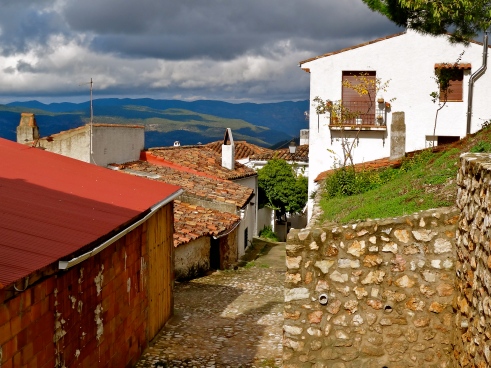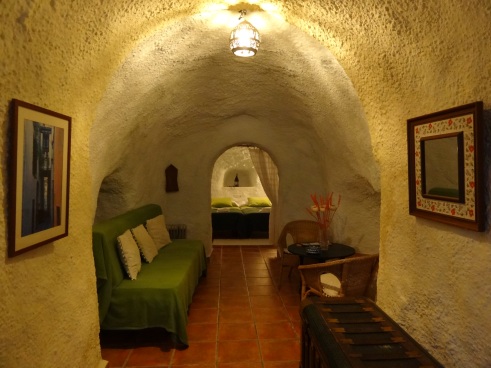After my recent trip to Spain, many of you have written to me to ask questions like what’s the best time to visit the country, and whether it’s really possible for a vegetarian to survive without eating supermarket food. Here are ten travel tips to make your travel planning to Spain simpler:
1. What’s the best time to go to Spain?
I skipped Spain during my first trip to Europe, assuming it will be unbearably hot in the land of sun, sea and sand in the months of May and June. My first impressions quickly changed that perception; the south of Spain indeed gets hot in the summer, but the more mountainous terrain in the north of the country remains pleasant, with the occasional rain. Winter starts in early November, and although Spain remains warmer than other countries in western Europe, it becomes cold enough to need boots and a good overcoat, even in the south of Spain, where rain is hardly uncommon in early winter.
So, according to me, the best time to travel to the south of Spain (Almeria, Andulusia, Jaen, Granada, Huelva), is just after the summer, from September to early November. This is also when the summer crowds have left, and autumn has painted the countryside in magical colors. On the other hand, the best time to visit the north of Spain (Basque Country, Cantabria, Asturia, Galicia) is in the summer months, between May and July.

2. How to get a Schengen visa for Spain?
Applying for a Schengen visa is never fun, certainly not when you own an Indian passport. If Spain is your first (or only) country of arrival in Europe, you need to apply early for a visa, which can take up to fifteen working days to be issued. Bear in mind that besides public holidays in India, the Spain embassy is also shut for public holidays in Spain.

3. What to pack for Spain?
If you intend to travel to the south of Spain in summer, you better stock up on summer wear and lots of sunblock, whereas if you’re headed north, carrying warm clothes and a good umbrella is essential; the north, especially Asturias, is prone to rainfall round the year.
Depending on whether or not you’re used to Europe’s chill, I would recommend stocking for winter in Spain as you would for any other European country. It is warmer than say France or Italy in the winter, but way colder than winter in Delhi, as I would find out the hard way. Checking the weather forecast on your travel dates is a good place to start.

4. Do they speak English in Spain?
I mentioned how not being able to get by speaking English in Spain was a myth. Truth is, I spent that week travelling on a press trip with Spain Tourism, which means we got around in chartered buses and taxis, stayed in non-budget hotels, and had English-speaking guides accompany us at most times. The moment I stepped out of that bubble and into the countryside of Spain, English was neither spoken, nor understood. It is almost impossible to check in, ask for room service, understand directions or timings, negotiate, and order vegetarian food, without some basic knowledge of Spanish, the primary language spoken in Spain. In Barcelona and the rest of Catalonia, Catalan is more commonly spoken, but Spanish is universally understood throughout the country.
Unlike France, people in Spain don’t tend to judge you if you don’t speak Spanish, but for practical reasons and especially if you want to interact with the local people, a crash course before your trip is highly recommended! (I intend together to put a list of the most helpful Spanish travel phrases and share them here soon).

5. Is Spain expensive?
Having travelled in other countries in western Europe, like Italy, Germany, France, Austria and Netherlands, I thought Spain was as expensive as an average European country. A meal at a small cafe will cost you an average of 4-6 Euros per person, whereas eating out in a decent restaurant could range from 20-25 Euros per person. Tapas bars are relatively cheap, especially in Andalusia, where the concept of tapas first originated, and it is easy to score free tapas with a drink or during happy hours. Public transport in Spain is cheaper than that in France, and a 2-3 hour bus journey on the southern countryside will cost only 5-6 Euros (it varies in different parts of the south though). Accommodation costs largely depend on what kind of a place you stay in; we found good deals for lovely boutique hotels at 45-55 Euros a night for a double.
On average, a budget of 100 Euros for two people per day is a very comfortable estimate, including staying at nice budget hotels, eating and drinking at local cafes or tapas bars, getting around with public transport, and indulging in the occasional fancy meal or Flamenco performance.

6. Can you find vegetarian food in Spain?
I can’t stop quoting Lonely Planet’s Spain guide, which notoriously states that a vegetarian travelling in Spain is advised to carry a small stash of vitamins and a big sense of humor! I have to admit that Spain can be tough as a vegetarian, but having survived (and often been culinarily delighted) for a month in the country, it is certainly not impossible! The main challenge in Spain is that rice or wheat are not part of Spain’s staple, atleast on the southern countryside, and rice is considered a Sunday treat in most countryside towns. The locals literally eat meat or ham for every meal; even at breakfast, among cheese and butter spreads, spreads with atun (tuna) and jamon (ham) often show up!
During the first week of my trip, I could indulge in higher end restaurants, courtesy Spain Tourism, and was delighted to have customized vegetarian Spanish meals whipped for me. I would highly recommend indulging in atleast one authentically Spanish meal at a nice restaurant, even if it means a slight dent in your wallet.
In bigger cities like Barcelona, Cordoba and Seville, international cuisines like Italian and Mexican, and regular sandwich shops are easy to find, which serve up a handful of vegetarian dishes. In smaller towns and villages however, you are at the mercy of local joints that pretty much offer potatoes, tomatoes and eggs in the name of vegetarian food! In my month-long trip, I probably ate eggs and potatoes in all possible shapes and forms, and occasionally got lucky in finding a pizza joint at a bus station or in a small town.
It is essential to know the names of the ingredients to be able to order vegetarian food, and even more essential to specify that you don’t want any form of meat, fish and especially ham in your food. I learnt the latter the hard way!

7. Do you need a Eurail Pass for Spain?
I ended up in Spain without a Eurail pass, simply because between getting my Schengen visa and tying lose ends before my almost impromptu trip, I had no time to get one. Also because the two country pass for Spain and Portugal doesn’t come with the awesome youth discount. Luckily, it all worked out in my favor; I never did end up going to Portugal, and bus transportation in Spain is way cheaper than trains. That’s right, I didn’t end up taking a single train in my entire trip!
Every state in the south of Spain has its own state company, but the Alsa bus service connects many of the routes and has accurate timetables on its website. In many smaller villages, even the locals were unsure of what time a bus would arrive, especially on the weekend, but Alsa solves that. The buses are comfortable, arrive and depart exactly on time, are almost 50% cheaper than trains, many offer Wifi on board, and have connections pretty much everywhere in Spain.

8. Where to go in Spain?
Unlike my trip to Europe, where I hopped from one country to another in western Europe, I decided to spend my second trip to Europe entirely in Spain. I wanted to make my way slowly through the gorgeous countryside of the south, taking in the endless fields of olive and the postcard villages, practicing what little Spanish I knew, sampling what vegetarian food I could find, discovering the hidden gems of the much-treaded south, soaking in the beauty of autumn, and essentially, living like a Spaniard, complete with long lunches, longer siestas, and indulging in Flamenco music and the Spanish guitar (though the last is reduced to the gypsy quarters now). Our plans were impulsive and flexible, and our final route turned out to be: Barcelona >> Almeria (Tabernas and San Jose) >> Granada >> Jaen (Segura de la Sierra and Baeza) >> Andalusia (Cordoba and Seville) >> Huela (El Rocio). I loved all of it, though I did crave for warmer weather in Jaen!
I did end up doing a fair bit of research on the north of Spain, but dropped that plan for not being sufficiently equipped for the cold. I most wanted to see the cidar and cheese country of Asturias, but everything else I read about sounded equally appealing.
My point is, Spain is not just about Barcelona and Madrid; its countryside has so much more to offer, and it would be a pity missing out on hiking through Europe’s only desert in Tabernas, living in the gypsy quarters of Granada, driving along the olive countryside of Jaen, watching a Flamenco performance in a cave in Cordoba, and seeing people get around on their horses in El Rocio. And I didn’t even see half of Spain!

9. Where to stay in Spain?
Like most of western Europe, Spain has plenty of artsy, boutique and family run accommodations to choose from. A great option is that of Casas Rurales, essentially a room, a studio or a full-fledged apartment rented for short-term stay by families, typically in small towns and villages along the countryside.

10. How to find Internet or Wifi in Spain?
One of the best parts of travelling in a developed country for a digital nomad or an internet addict is the ease of finding internet connectivity. Besides ensuring that all our accommodations offered free Wifi (most hotels and casas rurales do), we found Wifi connectivity in most public buses, as well as at many bus stations and cafes.
Most phone/SIM card operators like Vodafone have a strange rule in Spain, by which they don’t allow you top up your 3G/cellular data for more than 400MB! More crazy than the expense involved is the inconvenience. A local in Tarragona suggested using a Spanish operator instead, called Yoigo, which offers the standard 400MB of data, but free albiet slow cellular data for a month thereafter. And unlike the other operators, they don’t cut off your internet when the 400MB is over, they only deduct it from your main balance. Barring having to decode their occasional SMS using Google translate, it worked out just perfectly for the month I was there.

![]()

Shivya Nath is an Indian girl who fell in love with traveling, writing and social media. The first is the most thrilling, because being from a protective Indian family means every travel plan comes with a small battle. She says, “I’m not complaining. At my age, few from my hometown have traveled as much and as independently as me.”
She juggles work, travel and blogging, until she finds the perfect blend of the three. Join her on her journeys around the world, as she seeks the most untouched, undiscovered of places that few have been to, and even fewer have written out.








